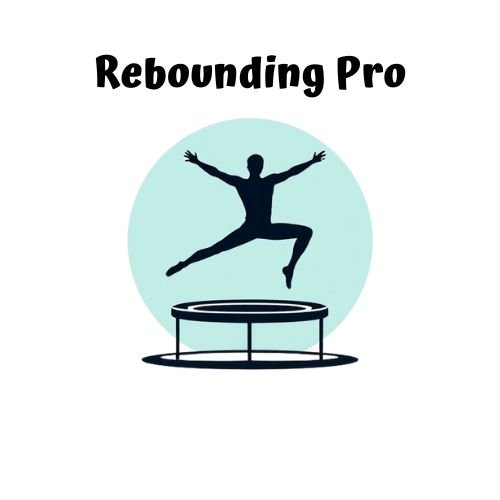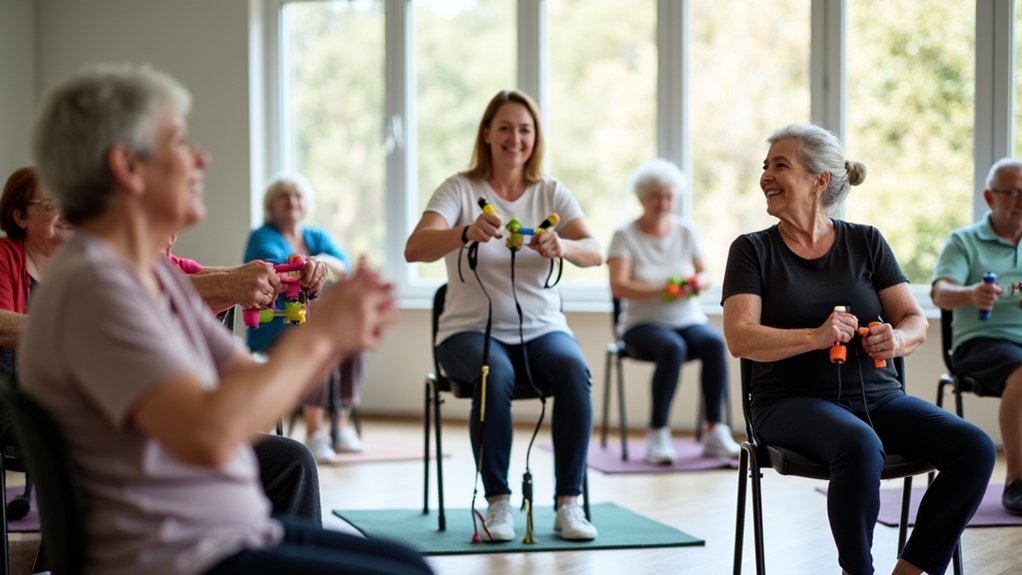Contrary to popular claims, NASA didn’t specifically study rebounding for lymphatic health. Their 1980 research focused on biomechanics and cardiovascular benefits, finding that trampolining creates twice the G-force of running and is 68% more efficient for fitness. While exercise generally supports lymphatic function through muscle contractions, NASA never endorsed rebounding for “detoxification.” Marketing has misrepresented these findings. Understanding the real science helps you separate fact from fiction in your fitness journey.
The Science Behind NASA’s Trampoline Investigations

Although commonly cited in rebounding advertisements, NASA’s trampoline studies from the 1980s weren’t actually focused on lymphatic health.
Instead, they examined the biomechanical effects of trampoline exercise in zero-gravity environments. The NASA study discovered that jumping on a trampoline generated more than twice the G-force compared to running, creating greater biomechanical stimuli and higher external work output.
While these findings highlight trampoline exercise’s efficiency for cardiovascular fitness, they don’t provide evidence connecting rebounding to lymphatic system improvements.
Any claims suggesting NASA proved lymphatic health benefits from trampolining are misleading. The research simply wasn’t designed to evaluate lymphatic circulation or detoxification processes.
When you’re considering a trampoline for health benefits, it’s important to distinguish between the actual research findings and marketing exaggerations.
Critical Analysis of the 1980 NASA Rebounding Study
Despite its frequent citation in rebounding marketing materials, NASA’s 1980 study titled “Body Acceleration Distribution and O₂ Uptake in Humans During Running and Jumping” warrants closer examination.
While NASA studied trampoline exercise for its efficiency in zero gravity environments, the research never mentioned lymph flow or detoxification benefits that are commonly claimed.
- The Truth: Scientific evidence shows the study focused on biomechanics and cardiovascular effects, not lymphatic health.
- The Misconception: Marketing claims often incorrectly state NASA endorsed rebounding for lymphatic detoxification.
- The Reality: Though rebounding may help with bone loss prevention, NASA’s research specifically measured G-forces at different body points during exercise—not lymphatic circulation.
When evaluating rebounding benefits, you should distinguish between NASA’s actual findings and unsubstantiated marketing claims.
Lymphatic System Function and Exercise Response

While your body has a heart to pump blood, the lymphatic system lacks such a central pump, instead relying on muscle contractions and body movements to circulate lymph fluid throughout its network. This waste removal system absorbs fluid from blood vessels and transports pathogens for immune response.
Any exercise, including rebounding, stimulates lymphatic circulation through muscle contractions. NASA’s research demonstrated that rebounding can produce greater biomechanical stimuli than running, potentially engaging more muscle groups and improving overall circulation. Their study showed increased G-force at the ankle during trampoline jumping compared to traditional exercise.
Despite popular claims about rebounding’s specific benefits for lymphatic health, scientific evidence remains limited. Your body’s natural processes generally maintain sufficient lymph flow without specialized activities, though exercise broadly supports this system’s function.
Comparing Rebounding to Traditional Cardiovascular Exercise
When compared to traditional running, rebounding presents remarkable efficiency advantages that might surprise fitness enthusiasts. NASA’s research confirms you’ll burn more calories in just 10 minutes of rebounding than 30 minutes of running—a 68% efficiency improvement for your cardiovascular exercise routine.
Rebound your way to fitness in 1/3 the time with NASA-proven efficiency that traditional running can’t match.
You’ll experience these significant benefits for your lymphatic health:
- Superior results in less time – accomplish more effective cardiovascular conditioning in just one-third of the time
- Protected joints and tissues – enjoy a low-impact exercise that reduces injury risk while maximizing lymphatic flow
- Easier than expected workouts – feel 10% less exertion than anticipated, making rebounding a sustainable fitness choice
This science-backed approach delivers enhanced lymphatic circulation and cardiovascular benefits while being gentler on your body than conventional exercise options.
Safety Considerations and Injury Prevention in Rebounding

While rebounding offers lymphatic benefits, you’ll need to prioritize safety to avoid joining the 300,000+ annual trampoline injuries in the U.S.
Proper technique includes maintaining a stable core, keeping jumps moderate in height, and landing with slightly bent knees to absorb impact.
Using quality equipment with safety features like protective nets and padding will greatly reduce your risk of sprains, fractures, and other injuries common to this exercise form.
Preventing Trampoline Injuries
Despite the lymphatic benefits of rebounding, safety must remain your top priority when using mini-trampolines or larger recreational models.
With over 300,000 trampoline injuries reported annually in the U.S., implementing proper safety measures is essential, especially for children aged 5-14 who face the highest risk.
- Install safety equipment – While nets and pads can’t eliminate all risks, they greatly reduce the chance of falls and contact injuries that could sideline your lymphatic exercise routine.
- Seek proper training – Learning correct jumping techniques dramatically decreases your injury risk while maximizing lymphatic benefits.
- Consult a healthcare professional – If you have pre-existing conditions, particularly spine issues, get medical clearance before starting a rebounding program to guarantee you’re not putting yourself at unnecessary risk.
Proper Rebounding Technique
Mastering proper rebounding technique transforms this lymphatic-boosting exercise from potentially risky to remarkably beneficial. Start with the gentle “Health Bounce” to properly stimulate lymph fluid movement without overwhelming your system. Keep your core engaged and posture straight while landing softly to minimize impact on joints.
| Do’s | Don’ts |
|---|---|
| Wear supportive footwear | Bounce with poor posture |
| Use stability bar if needed | Ignore equipment maintenance |
| Land softly on the mat | Jump too high as a beginner |
Regular equipment inspection prevents accidents – check springs and mat integrity before each session. As you progress, you’ll notice improved lymphatic circulation while maintaining safety. Remember, efficient rebounding isn’t about height but about controlled, consistent movement that safely stimulates your lymphatic system without risking injury.
Research Gaps and Future Directions in Lymphatic Health Studies
Although enthusiasts frequently tout rebounding as a miracle solution for lymphatic health, the scientific community faces significant gaps in research that would validate these claims.
The 2018 pilot study on trampoline use for lymphedema delivered inconclusive results, while NASA’s 1980 research never actually examined lymphatic flow despite being commonly cited by rebounding advocates.
You’ll find these critical research gaps need addressing:
- No long-term studies measuring rebounding’s direct effects on lymphatic circulation or detoxification
- Limited comparison research between rebounding and proven treatments like compression therapy
- Absence of controlled clinical trials with adequate sample sizes or methodology
Future directions in lymphatic health studies should prioritize evidence-based approaches rather than relying on anecdotal claims that currently dominate the rebounding conversation.
Practical Applications of NASA’s Findings for Everyday Fitness
NASA’s groundbreaking research on rebounding offers you practical fitness solutions that are 68% more effective than jogging while taking just one-third of the time.
You’ll find trampoline therapy particularly beneficial for lymphatic health, as the rhythmic bouncing stimulates fluid movement without stressing your joints.
Incorporating daily rebound routines of just 10 minutes can revolutionize your fitness regimen, delivering cardiovascular benefits, improved balance, and enhanced muscle strength with remarkable efficiency.
Trampoline Therapy Benefits
When researchers at NASA discovered that rebounding could be 68% more efficient than jogging, they opened a gateway to practical fitness applications that extend far beyond astronaut training.
Trampoline therapy offers a unique combination of benefits that make it an exceptional addition to your fitness routine.
- Time-efficient calorie burning – You’ll achieve more in less time, as just 10 minutes of bouncing burns more calories than 30 minutes of running.
- Joint-friendly exercise – Your body experiences the cardiovascular benefits of intense exercise without the harsh impact of running.
- Enhanced lymphatic function – The varying gravitational forces during rebounding may improve fluid circulation throughout your body, potentially boosting your immune system.
The full-body engagement of trampoline workouts also improves your balance, coordination, and core strength simultaneously.
Daily Rebound Routines
Transforming scientific discovery into practical daily fitness doesn’t have to be complicated, especially with rebounding exercise. With NASA’s research showing rebounding is 68% more efficient than jogging, you’re getting maximum lymph circulation with minimal time investment.
Start with just 2-5 minutes of gentle bouncing daily, gradually increasing as your body adapts. Remarkably, 10 minutes on your rebounder burns more calories than 30 minutes of running, while simultaneously strengthening leg muscles and improving balance.
For ideal lymph flow and thorough health benefits, incorporate rebounding into your daily routines rather than sporadic intense sessions. Your cardiovascular system responds well to the consistent elevation in heart rate, enhancing overall endurance without the joint stress of high-impact exercises.
This NASA-backed approach delivers extensive fitness through manageable, effective daily sessions.
Low-Impact Exercise Efficiency
The groundbreaking efficiency of rebounding emerges clearly in NASA’s research findings, offering practical solutions for time-conscious fitness enthusiasts.
You’ll achieve greater results in less time—just 10 minutes of bouncing equals 30 minutes of running—while protecting your joints from high-impact stress.
This efficient exercise helps increase bone density while stimulating your circulatory system to flush out toxins through enhanced lymphatic flow.
Consider these compelling benefits:
- 68% more effective than jogging with markedly less perceived exertion
- Lower joint impact while achieving greater cardiovascular improvement
- Consistent workout adherence due to the enjoyable, playful nature of rebounding
With rebounding, you’re not just saving time—you’re maximizing every minute of physical activity while protecting your body’s long-term health.
Frequently Asked Questions
Does NASA Recommend Rebounding?
No, NASA doesn’t officially recommend rebounding. While they studied trampoline exercise for fitness in zero gravity environments, they haven’t endorsed rebounding as a necessary exercise for general health or lymphatic system benefits.
Does Rebounding Really Help the Lymphatic System?
While rebounding provides exercise benefits, there’s no scientific evidence it specifically helps your lymphatic system. Claims linking rebounding to lymphatic health aren’t supported by research. For lymphatic issues, consider proven treatments like compression therapy instead.
Is Rebounding Scientifically Proven?
No, rebounding isn’t scientifically proven for lymphatic health. While NASA’s 1980 study showed it’s an efficient exercise, specific claims about lymphatic benefits lack rigorous scientific evidence and remain largely anecdotal.
What Do Doctors Say About Rebounding?
Doctors generally view rebounding as a beneficial low-impact exercise for fitness and cardiovascular health. They’ll encourage you to try it, especially if you have joint concerns, but suggest consulting your physician before starting.
In Summary
You’ve learned how NASA’s research on rebounding isn’t just about astronaut fitness—it’s about your lymphatic health too. While the 1980 study has limitations, rebounding offers a low-impact alternative that may enhance lymphatic circulation. Remember to prioritize safety and proper technique if you’re incorporating mini-trampolines into your routine. As research evolves, you’ll likely see more evidence connecting rebounding to improved lymphatic function and overall wellness.





Leave a Reply